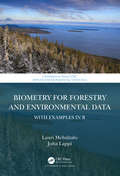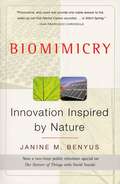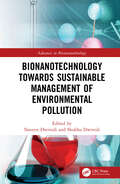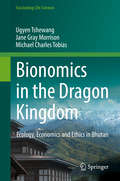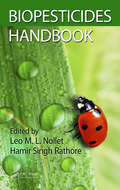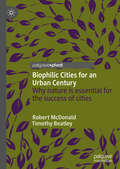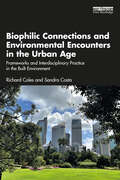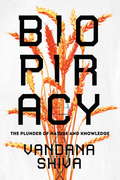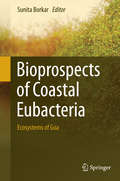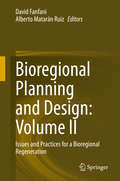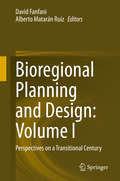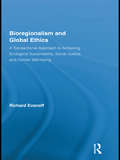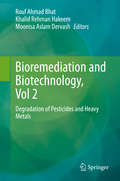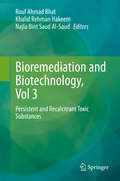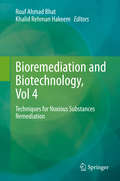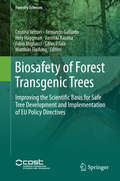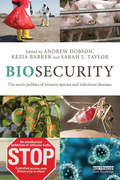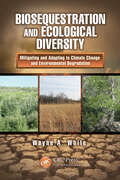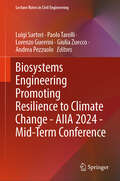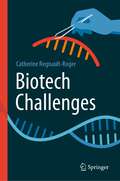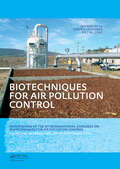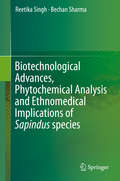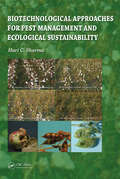- Table View
- List View
Biometry for Forestry and Environmental Data: With Examples in R
by Lauri MehtataloBiometry for Forestry and Environmental Data with Examples in R focuses on statistical methods that are widely applicable in forestry and environmental sciences, but it also includes material that is of wider interest. Features: · Describes the theory and applications of selected statistical methods and illustrates their use and basic concepts through examples with forestry and environmental data in R. · Rigorous but easily accessible presentation of the linear, nonlinear, generalized linear and multivariate models, and their mixed-effects counterparts. Chapters on tree size, tree taper, measurement errors, and forest experiments are also included. · Necessary statistical theory about random variables, estimation and prediction is included. The wide applicability of the linear prediction theory is emphasized. · The hands-on examples with implementations using R make it easier for non-statisticians to understand the concepts and apply the methods with their own data. Lot of additional material is available at www.biombook.org. The book is aimed at students and researchers in forestry and environmental studies, but it will also be of interest to statisticians and researchers in other fields as well.
Biomimicry
by Janine M. BenyusThis profound and accessible book details how science is studying nature's best ideas to solve our toughest 21st-century problems. If chaos theory transformed our view of the universe, biomimicry is transforming our life on Earth. Biomimicry is innovation inspired by nature - taking advantage of evolution's 3.8 billion years of R&D since the first bacteria. Biomimics study nature's best ideas: photosynthesis, brain power, and shells - and adapt them for human use. They are revolutionising how we invent, compute, heal ourselves, harness energy, repair the environment, and feed the world. Science writer and lecturer Janine Benyus names and explains this phenomenon. She takes us into the lab and out in the field with cutting-edge researchers as they stir vats of proteins to unleash their computing power; analyse how electrons zipping around a leaf cell convert sunlight into fuel in trillionths of a second; discover miracle drugs by watching what chimps eat when they're sick; study the hardy prairie as a model for low-maintenance agriculture; and more.
Biomimicry and Business: How Companies Are Using Nature's Strategies to Succeed
by Margo FarnsworthBiomimicry, the practice of observing then mimicking nature’s strategies to solve business challenges, offers a path to healthy profit while working in partnership, and even reciprocity, with the natural world. Other books have described biomimicry, its uses, and its benefits. This book shows readers how to create their own biomimetic or bioinspired solutions with clear benefits to the bottom line, the environment, and people. Fashioned through storytelling, this book blends snapshots of five successful companies – Nike, Interface, Inc., PAX Scientific, Sharklet Technologies, and Encycle – which decided to partner with nature by deploying biomimicry. The book details how they discovered the practices, introduced them to staff, engaged in the process, and measured outcomes. The book concludes with challenges for readers to determine their own next steps in business and offers practical and useful resources to get there. By revealing the stories of each professional’s journey with lessons they learned, then providing resources and issuing a challenge and pathway to do business better, this book serves as a tool for entrepreneurs, seasoned professionals, and students to emulate nature’s brilliance, apply it at work, and contribute to a healthier, more prosperous world.
Bionanotechnology Towards Sustainable Management of Environmental Pollution (Advances in Bionanotechnology)
by Naveen Dwivedi Shubha DwivediThis book highlights the characteristics, aims, and applications of bionanotechnology as a possible solution for sustainable management and bioremediation of environmental pollutants. It covers remediation of toxic pollutants, removal of emerging contaminants from industrial wastewater, eco-design and modification study of bio-nanoparticles and life-cycle assessment, nano-filtration, bio-nanomaterials based sensors for monitoring air and water pollution, resource recovery from wastewater, and highlights Internet of things-based green nanotechnology.Provides a comprehensive solution of environmental problems in sustainable and cost-effective modeReviews bionanotechnological applications in nanomaterials design, modification, and treatment of emerging contaminants from industrial wastewater.Covers Eco-design study of bio-nanomaterials, bio-nano filters, and assessment for the treatment of emerging pollutantsIncludes IoT- based bionanotechnologyExplores future research needs on bionanotechnology and scientific challenges in the mitigation of environmental pollutantsThis book is aimed at researchers, professionals, and graduate students in nanobiotechnology, environmental engineering, biotechnology.
Bionomics in the Dragon Kingdom: Ecology, Economics and Ethics in Bhutan (Fascinating Life Sciences)
by Michael Charles Tobias Jane Gray Morrison Ugyen TshewangThis compact and elegant work (equally fitting for both academic as well as the trade audiences) provides a readily accessible and highly readable overview of Bhutan’s unique opportunities and challenges; all her prominent environmental legislation, regulatory statutes, ecological customs and practices, both in historic and contemporary terms. At the same time, Bionomics places the ecological context, including a section on animal rights in Bhutan, within the nation’s Buddhist spiritual and ethical setting. Historic contextualization accents the book’s rich accounting of every national park and scientific reserve, as well as providing up-to-the-minute climate-change related hurdles for the country.Merging the interdisciplinary sciences, engineering and humanities data in a compelling up-to-date portrait of the country, the authors have presented this dramatic compendium against the backdrop of an urgent, global ecological time-frame. It thus becomes clear that the articulated stakes for Bhutan, like her neighboring Himalayan and Indian sub-continental countries (China, India, Bangladesh and Myanmar) are immense, as the Anthropocene epoch unfolds, affecting every living being across the planet. Because Bhutan’s two most rewarding revenue streams derive from the sale of hydro-electric power and from tourism, the complexities of modern pressures facing a nation that prides herself on maintaining traditional customs in what has been a uniquely isolated nation are acute.
Biopesticides Handbook
by Hamir Singh Rathore Leo M. L. NolletThe need to feed an ever-growing global population combined with increasing demand for sustainable agricultural practices has generated a significant rise in demand for biopesticides. By responding concurrently to the interests of farming, forestry, and industrial sectors, biopesticides offer a considerable potential for utilization in sustainable
Biophilic Cities for an Urban Century: Why nature is essential for the success of cities
by Timothy Beatley Robert McDonaldThis book argues that, paradoxically, at their moment of triumph and fastest growth, cities need nature more than ever. Only if our urban world is full of biophilic cities will the coming urban century truly succeed. Cities are quintessentially human, the perfect forum for interaction, and we are entering what could justly be called the urban century, the fastest period of urban growth in human history. Yet a growing body of scientific literature shows that the constant interaction, the hyper-connectedness, of cities leads to an urban psychological penalty. Nature in cities can be solution to this dilemma, allowing us to have all the benefits of our urban, connected world yet also have that urban home be a place where humanity can thrive. This book presents best practices and case studies from biophilic design, showing how cities around the world are beginning to incorporate nature into their urban fabric. It will be a valuable resource for scholars and professionals working in the area of sustainable cities.
Biophilic Connections and Environmental Encounters in the Urban Age: Frameworks and Interdisciplinary Practice in the Built Environment
by Richard Coles Sandra CostaBiophilic Connections and Environmental Encounters in the Urban Age takes a multi-disciplinary approach, drawing on the authors’ wide range of experience, to provide a greater understanding of the different dimensions of environmental engagement. It considers the ways that we interact with our environments, presenting a comprehensive account of how people negotiate and use the urban landscape. Set within current debates concerning urban futures, societal issues, sustainable cities, health and well-being, the book explores our innate need for contact with the natural world through biophilic design thinking to expand our knowledge base and promote a wider understanding of the importance of these interactions on our collective well-being. It responds to questions such as, what are the urban qualities that support our well-being? As an urbanised society what are the environmental determinants that promote healthy and satisfying lifestyles? Beginning with an overview of concepts relating to biophilia and environmental engagement, it moves through current theory and practice, different pathways and their characteristics, before presenting real world examples and applications through illustrated case studies in different world situations. With a particular focus on the experience of individuals, the book is essential reading for students, researchers, and practitioners of architecture, landscape architecture, urban planning, design and health sciences, interested in the future of our cities and the importance of green spaces.
Biopiracy: The Plunder of Nature and Knowledge
by Vandana ShivaGenetic engineering and the cloning of organisms are "the ultimate expression of the commercialization of science and the commodification of nature.... Life itself is being colonized," according to renowned environmentalist Vandana Shiva. The resistance to this biopiracy, she argues, is the struggle to conserve both cultural and biological diversity. As the land, forests, oceans, and atmosphere have already been colonized, eroded, and polluted, corporations are now looking for new colonies to exploit and invade for further accumulation--in Shiva's view, the interior spaces of the bodies of women, plants, and animals. Featuring a new introduction by the author, this edition of Biopiracy is a learned, clear, and passionately stated objection to the ways in which Western businesses are being allowed to expropriate natural processes and traditional forms of knowledge. From the Trade Paperback edition.
Bioprospects of Coastal Eubacteria: Ecosystems of Goa
by Sunita BorkarThis book is a collection of scholarly articles presenting the research results of work carried out under the supervision of Prof. Saroj Bhosle, a microbiologist at Goa University, India. The objective of this volume is to document the comprehensive ecological knowledge of eubacteria isolated from diverse coastal ecosystems of Goa, little explored for microbiological studies. These ecosystems need to be properly tapped in order to reveal potential bacteria yet to be exploited. The topics of this book are particularly relevant to researchers and students in the field of microbiology with an interest in the varied aspects of eubacteria. They provide academic insight for scientific communities in Goa and the rest of the world.
Bioregional Planning and Design: Issues and Practices for a Bioregional Regeneration
by David Fanfani Alberto Matarán RuizThis book provides insights and discusses the practical application of the theoretical concept of urban bioregion complementing the general bio-regional planning cross-disciplinary issues provided in Volume I. It examines planning practices, such as relocalisation of energy flows, land protection for climate change, territorial heritage enhancement, the consideration of urban ecosystems and agro-ecology. It presents discussions on regional contexts, practices and projects for a bioregional recovery, and includes case studies from France, Belgium, Spain, Greece, Austria and Italy, discussing topics that range from the reframing of local energy production/delivery planning systems to soil protection and farmland sustainable exploitation schemes. This volume concludes with three cross-European case studies that make clear the worldwide relevance and potential of bioregional approach beyond the Global North or Western countries.
Bioregional Planning and Design: Perspectives on a Transitional Century
by David Fanfani Alberto Matarán RuizThis book provides a review of the bioregionalist theory in the field of spatial planning and design as a suitable approach to cope with the growing concerns about the negative effects of metropolization processes and the need for a sustainable transition. The book starts out with a section on rethinking places for community life, and discusses the reframing of regional governance and development as well as social justice in spatial planning. It introduces the concept of the urban bioregion, a pivotal concept that underpins balanced polycentric spatial patterns and supports self-reliant and fair local development. The second part of the book focuses on planning, and particularly on the issues that arise from the ‘circular’ recovery of the relation between city and agro-ecosystems for integrated planning and resilience of settlements and discusses topics such as foodshed planning, biophilic urbanism and the integration of rural development and spatial planning. This volume sets out the reference framework for Volume II which deals with more specific and operational issues related to spatial policies and settlement design.
Bioregionalism and Global Ethics: A Transactional Approach to Achieving Ecological Sustainability, Social Justice, and Human Well-being
by Richard EvanoffWhile a number of schools of environmental thought — including social ecology, ecofeminism, ecological Marxism, ecoanarchism, and bioregionalism — have attempted to link social issues to a concern for the environment, environmental ethics as an academic discipline has tended to focus more narrowly on ethics related either to changes in personal values or behavior, or to the various ways in which nature might be valued. What is lacking is a framework in which individual, social, and environmental concerns can be looked at not in isolation from each other, but rather in terms of their interrelationships. In this book, Evanoff aims to develop just such a philosophical framework — one in which ethical questions related to interactions between self, society, and nature can be discussed across disciplines and from a variety of different perspectives. The central problem his study investigates is the extent to which a dichotomized view of the relationship between nature and culture, perpetuated in ongoing debates over anthropocentric vs. ecocentric approaches to environmental ethics, might be overcome through the adoption of a transactional perspective, which offers a more dynamic and coevolutionary understanding of how humans interact with their natural environments. Unlike anthropocentric approaches to environmental ethics, which often privilege human concerns over ecological preservation, and some ecocentric approaches, which place more emphasis on preserving natural environments than on meeting human needs, a transactional approach attempts to create more symbiotic and less conflictual modes of interaction between human cultures and natural environments, which allow for the flourishing of both.
Bioremediation and Biotechnology, Vol 2: Degradation of Pesticides and Heavy Metals
by Khalid Rehman Hakeem Rouf Ahmad Bhat Moonisa Aslam DervashThis book addresses the grave concerns stemming out due to conventional treatment techniques. The main focus of this book revolves round the central kernel of novel technology (bioremediation and biotechnology) which has emerged as an independent warrior to clean up and restore the disturbed environs. Furthermore, this book is a coherent assortment of diverse chapters relevant to the role of biotechnology and bioremediation for restoration of the ecosystems degraded by pesticide and heavy metal pollution. The inaugural chapters deal with the quantification of problem and its magnitude due to pesticides and heavy metals, followed by innovative modern biotechnological and bioremediation treatment technologies and sustainable techniques to remediate the persistent pollutants. It is a detailed comprehensive account for the treatment technologies from unsustainable to sustainable. Academicians, researchers and students shall find it as a complete wrap up regarding biotechnological intervention for sustainable treatment of pollution and shall suffice for the diverse needs of teaching and research.
Bioremediation and Biotechnology, Vol 3: Persistent and Recalcitrant Toxic Substances
by Khalid Rehman Hakeem Rouf Ahmad Bhat Najla Bint Saud Al-SaudHealthy environment is important for any kind of biota on earth. It provides the basic elements of life such as clean water, fresh air, fertile soil and supports ecosystem of the food chain. Pollution drastically alters quality of the environment by changing the physico-chemical and biological aspects of these components. Accordingly, toxic metals, combustible and putrescible substances, hazardous wastes, explosives and petroleum products are all examples of inorganic and organic compounds that cause contaminations. Specifically, pollution of toxic and heavy metal in the environment is a growing problem worldwide, currently at an alarming rate. Toxic metals threaten the aquatic ecosystems, agriculture and ultimately human health. Traditional treatment techniques offer certain advantages such as rapid processing, ease of operation and control and flexibility. But, they could not maintain the quality of the environment due to the high operational costs of chemicals used, high energy consumption and handling costs for sludge disposal and overburden of chemical substances which irreversibly affect and destroy biodiversity, which ultimately render the soil useless as a medium for plant growth. Therefore, bioremediation and biotechnology, carried out by living assets to clean up, stabilize and restore contaminated ecosystems, have emerged as promising, environmental friendly and affordable approaches. Furthermore, the use of microbes, algae, transgenic plants and weeds adapted to stressful environments could be employed to enhance accumulation efficiency. Hence, sustainable and inexpensive processes are fast emerging as a viable alternative to conventional remediation methods, and will be most suitable for developing countries.In the current volume, we discuss pollution remediation challenges and how living organisms and the latest biotechnological techniques could be helpful in remediating the pollution in ecofriendly and sustainable ways.
Bioremediation and Biotechnology, Vol 4: Techniques for Noxious Substances Remediation
by Khalid Rehman Hakeem Rouf Ahmad BhatThe rapid thriving of industries, conversion of agricultural land to residential areas, habitat destruction, deforestation and use of recalcitrant synthetic substances enhanced the rate of degradation of the environment. Although there are various conventional techniques for degradation and cleaning of noxious pollutants from disturbed environs, they are energy inefficient and costly to install. Bioremediation has emerged recently as an alternative and novel approach to manage and control environmental pollutants. This volume focuses explicitly on the remediation of noxious substances in stressed environs. It includes expert-contributed chapters on bio-monitoring by way of evaluating the relationship of biota with the polluted/stressed environs, sustainable plant-based degradation of noxious pollutants, and the application of biotechnologies to achieve tailored responses.Academicians, researchers, scientists and students will find this work essential for sustainable treatment of noxious pollutants. This book also serves as a core guide for training, teaching and research in conservation biology and environmental rehabilitation.
Biosafety of Forest Transgenic Trees: Improving the Scientific Basis for Safe Tree Development and Implementation of EU Policy Directives (Forestry Sciences #82)
by Cristina Vettori Fernando Gallardo Hely Häggman Vassiliki Kazana Fabio Migliacci Gilles Pilate Matthias FladungThis book provides up-to-date information on the environmental impact of transgenic trees on genetically modified tree (GMT) communication strategy. It is useful to public/private organisations as well as to private and public research bodies and universities worldwide since it reports on the global status of GMT research and policy. A high number of genetically modified trees (GMTs) with altered or novel characteristics have been produced in the last 15 years. However, their very low public acceptance is a basic problem in their commercialization. Breeders anticipate economic and ecological benefits, like reduced product costs and less pressure on native forests, while opponents fear risks, such as unintended spread of GMTs. But what is true? To answer this question, the COST Action FP0905 focused on key aspects related to GMTs: (a) biological characterization; (b) assessment of possible environmental impacts; (c) socio-economic implications and public acceptance/concerns; (d) providing science-based information to communicate with the public.
Biosecurity: The Socio-Politics of Invasive Species and Infectious Diseases (Routledge Environment And Sustainability Handbooks Ser.)
by Andrew Dobson Kezia Barker Sarah L. TaylorBiosecurity is the assessment and management of potentially dangerous infectious diseases, quarantined pests, invasive (alien) species, living modified organisms, and biological weapons. It is a holistic concept of direct relevance to the sustainability of agriculture, food safety, and the protection of human populations (including bio-terrorism), the environment, and biodiversity. Biosecurity is a relatively new concept that has become increasingly prevalent in academic, policy and media circles, and needs a more comprehensive and inter-disciplinary approach to take into account mobility, globalisation and climate change. In this introductory volume, biosecurity is presented as a governance approach to a set of concerns that span the protection of indigenous biological organisms, agricultural systems and human health, from invasive pests and diseases. It describes the ways in which biosecurity is understood and theorized in different subject disciplines, including anthropology, political theory, ecology, geography and environmental management. It examines the different scientific and knowledge practices connected to biosecurity governance, including legal regimes, ecology, risk management and alternative knowledges. The geopolitics of biosecurity is considered in terms of health, biopolitics and trade governance at the global scale. Finally, biosecurity as an approach to actively secure the future is assessed in the context of future risk and uncertainties, such as globalization and climate change.
Biosequestration and Ecological Diversity: Mitigating and Adapting to Climate Change and Environmental Degradation (Social Environmental Sustainability)
by Wayne A. WhiteIncreased throughput of carbon-based fossil energy, the destruction of Earth's forests, and other land use changes have resulted in ever higher levels of waste in the form of greenhouse gases-as well as a diminished capacity of the planet to absorb and store those wastes. This means that to avoid catastrophic global warming and maintain the habitab
Biosphere Politics: A New Consciousness for a New Century
by Jeremy RifkinThe post-modern world of the 21st century, where our personal and public lives are transformed, reflecting a whole new way of thinking and acting in the world.
Biosystems Engineering Promoting Resilience to Climate Change - AIIA 2024 - Mid-Term Conference (Lecture Notes in Civil Engineering #586)
by Paolo Tarolli Luigi Sartori Lorenzo Guerrini Giulia Zuecco Andrea PezzuoloThis book gathers the latest advances and innovations in the field of innovative biosystems engineering for sustainable agriculture, forestry and food production, as presented at the International Mid-Term Conference of the Italian Association of Agricultural Engineering (AIIA), held in Padova, Italy, on June 17-19, 2024. Focusing on the challenges of implementing sustainability in various contexts in the fields of biosystems engineering, it shows how the research has addressed the sustainable use of renewable and non-renewable resources. It also presents possible solutions to help achieve sustainable production. The Mid-Term Conference of the Italian Association of Agricultural Engineering (AIIA) is part of a series of conferences, seminars and meetings that the AIIA organizes, together with other public and private stakeholders, to promote the creation and dissemination of new knowledge in the sector. The contributions included in the book were selected by means of a rigorous peer-review process, and offer an extensive and multidisciplinary overview of interesting solutions in the field of innovative biosystems engineering for sustainable agriculture.
Biotech Challenges
by Catherine Regnault-RogerThe evolution of genome’s modification by genetic engineering was characterized by a major technological breakthrough with the discovery of CRISPR in 2012. A distinction is now made between first-generation biotechnologies developed in the 20th century and current second-generation biotechnologies, NGT or New Genomic Techniques, including genome editing. How do we consider these genomic modifications compared to those that occur spontaneously in nature? What are the applications of these techniques in the fields of plants, animals, and human health? What prospects in terms of development and independence for countries and at least what regulations are in force on the different continents?The book questions what GMOs are, genome editing products and the place of genomic transformations today and tomorrow in our societies. It tries to give some geostrategic and regulatory benchmarks on biotech products in order to better understand the current issues.
Biotechniques for Air Pollution Control: Proceedings of the 3rd International Congress on Biotechniques for Air Pollution Control. Delft, The Netherlands, September 28-30, 2009
by Christian Kennes Piet N.L. Lens Jan BartacekEnergy and feedstock materials for the chemical industry show an increasing demand. With constraints related to availability and use of oil, the energy and chemical industry is subject to considerable changes. The need for the use of cheaper and widely available feedstocks, and the development of sustainable and environmentally friendly c
Biotechnological Advances, Phytochemical Analysis and Ethnomedical Implications of Sapindus species
by Reetika Singh Bechan SharmaPlants have always occupied a prominent position in the life of every living being. Plants are the primary source of food, shelter and medicines. The global inclination toward herbal medicine has advanced the expansion of plant-based pharmaceutical industries to a vast extent. The production of traditional medicine at global market has been estimated to touch US $5 trillion by 2050. Some of the useful plant-based drugs include vinblastine, vincristine, taxol, podophyllotoxin, camptothecin, digoxigenin, morphine, codeine, aspirin, atropine, capscicine, allicin, curcumin, artemesinin and ephedrine. Genus Sapindus is an important economical and medicinal trees, distributed over the world. Soap nuts contain higher amount of saponin, a natural detergent which can be used to clean clothes and hairs. Sapindus species possesses various pharmacological properties including antimicrobial, antioxidant, anti-inflammatory, anticancer, hepatoprotective, anti-trichomonas activity. Extracts of this plant are rich in various phytochemicals and polyphenolic compounds. All the pharmacological properties are due to presence of saponins. Biotechnological techniques can improve the saponin content; thus this chemical content can be produced at large scale and can be used as phytomedicine. We hope that this book would be of great use to under graduates, postgraduates, scientists, researchers and faculty members who are studying, teaching or working in the field of Biotechnology, Phytochemistry and Ethnopharmacology. The techniques explained in this book could be of immense use for the researchers working in this area. We shall deeply appreciate receiving any critical comments and suggestions from the readers from the different parts of globe which would help us improve the first edition of this publication.
Biotechnological Approaches for Pest Management and Ecological Sustainability
by Hari C SharmaDue to increasing problems occurring from massive applications of pesticides, such as insect resistance to pesticides, the use of biotechnological tools to minimize losses from insect pests has become inevitable. Presenting alternative strategies for alleviating biotic stresses, Biotechnological Approaches for Pest Management and Ecological Sustain
